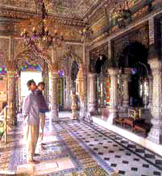|
Religion
The majority of the
state's population is grouped under the generic
denomination of Hindu. There is a sizeable Muslim minority. The other minority
communities are Christians, Buddhist, Sikhs and Jains.
The term Hindu
covers a
number of religious sect ranging from monotheists to polytheists in various
degrees. The religious sect with the largest following is Vaishnavism, mainly of
the Chaitanya cult. Of the minor Bhakti cult sects the most interesting is the
Sahajiya sect, which does not recognise difference of caste and community and the
convention of social life. The next in order are the Shaktas and Saivas. Ritual
Brahmanism derived from the Vedic Aryan cult is practised by a fraction of
the Brahmin caste. Popular Hinduism in Bengal is an amalgam of pre-Aryan sects. These
influences are evident not only among the Hindu Community but among the Muslims
and Christians in a considerable degree. The Bhakti cult of which Vaishnavism is
a refinement, has been an ancient feature of the religious thought of Bengal and
is perhaps the strongest element in the spiritual beliefs of the people
irrespective of community. Social behaviour of this plural structure of Hinduism
is traditionally controlled by the caste system with a clear cut division
between the entire Hindu community and the other communities. Bengal was the home of numerous castes and sub-castes which did not confirm
to the Varna classification but which were arranged according to the hereditary
occupations.
 The highest in the traditional caste
hierarchy are the Brahmins, who claim
descent from pure Aryan stock. In fact they have had the monopoly of
the priestly occupation and almost the sole guardianship of Sanskritic learning,
particularly the sacred scriptures, until the reform movement of the
nineteenth century when other castes admitted themselves to the study of the
scriptures in the original Sanskrit and in Bengali translations. The next in
order of the precedence are the Vaidyas supposed to have evolved from inter
caste unions of Brahmins and the immediately lower castes who hereditarily
practised the science and art of Hindu medicine. Backed by their learning
in Sanskrit they recently laid claim to the status of Brahmins. The third in order
are the Kayasthas the most numerous among the higher castes who lightly claim to
be of the Kshatriya descent. That the Kayastha caste is fairly ancient,
can be proved by references in the later Puranas and Samhitas and by their
geographical distribution from Bengal to Punjab. Their traditional occupation
was white collar activity - clerks, book keepers, scribers for the ruling
authority and the like. The Bengal Brahmins and Kayasthas are not admitted to
marriage relationship with their counterpart in other regions. In certain late
Puranas which seem to have originated in Bengal the Kayasthas are classed as
Sat-Sudras or good Sudras. The highest in the traditional caste
hierarchy are the Brahmins, who claim
descent from pure Aryan stock. In fact they have had the monopoly of
the priestly occupation and almost the sole guardianship of Sanskritic learning,
particularly the sacred scriptures, until the reform movement of the
nineteenth century when other castes admitted themselves to the study of the
scriptures in the original Sanskrit and in Bengali translations. The next in
order of the precedence are the Vaidyas supposed to have evolved from inter
caste unions of Brahmins and the immediately lower castes who hereditarily
practised the science and art of Hindu medicine. Backed by their learning
in Sanskrit they recently laid claim to the status of Brahmins. The third in order
are the Kayasthas the most numerous among the higher castes who lightly claim to
be of the Kshatriya descent. That the Kayastha caste is fairly ancient,
can be proved by references in the later Puranas and Samhitas and by their
geographical distribution from Bengal to Punjab. Their traditional occupation
was white collar activity - clerks, book keepers, scribers for the ruling
authority and the like. The Bengal Brahmins and Kayasthas are not admitted to
marriage relationship with their counterpart in other regions. In certain late
Puranas which seem to have originated in Bengal the Kayasthas are classed as
Sat-Sudras or good Sudras.
|

